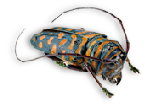







Context
Locomotion on sand is somewhat unusual because this granular medium behaves both as a solid and as a liquid. Antlion larvae benefit from this characteristic to capture preys. Indeed, they build a critically stable conical trap in sand and wait at the centre. When an arthropod, fallen into the (solid) trap, tries de leave it, its movements can start a (liquid) avalanche that moves it towards the predator. The trap efficiency depends on many variables associated with the larva (size, satiety …), the sand (particle size, moisture) and the trap (diameter, depth…). These variables may partly act by changing the prey locomotion into the trap. Yet, the trap mechanisms are largely unknown for the prey point of view.
So, the aim of my PhD is to understand how and in which circumstances an arthropod can leave the antlion trap.
Locomotion on sand is somewhat unusual because this granular medium behaves both as a solid and as a liquid. Antlion larvae benefit from this characteristic to capture preys. Indeed, they build a critically stable conical trap in sand and wait at the centre. When an arthropod, fallen into the (solid) trap, tries de leave it, its movements can start a (liquid) avalanche that moves it towards the predator. The trap efficiency depends on many variables associated with the larva (size, satiety …), the sand (particle size, moisture) and the trap (diameter, depth…). These variables may partly act by changing the prey locomotion into the trap. Yet, the trap mechanisms are largely unknown for the prey point of view.
So, the aim of my PhD is to understand how and in which circumstances an arthropod can leave the antlion trap.
Goals
Firstly, the trap retains preys within the range of the predator because it complicates the escape. I want to understand which are the consequences of the trap for the insect locomotion. So, I compare the locomotion of ants in the trap with other substrates. More precisely, I consider the hardness, the roughness and the slope of the substrate.
Different insect species don’t escape with the same difficulty. So I want to compare the locomotion of ants, the main antlion prey with firebugs, which can escape relatively easily.
Intuitively, the trap functioning appears very dependent on the sand reactions under the legs and the slope could be a very important factor for the trap functioning. In order to verify this hypothesis, I
Keywords:
larvae, biomechanics, granular media, prey-predator interactions
larvae, biomechanics, granular media, prey-
2012-present. PhD student, IRBI (France)
2009-2011. Master Functional, Behavioral and Evolutionary Ecology, University of Rennes 1 (France)
2009-
Locomotion of arthropods on the sand and in the antlion trap



Institut de Recherche sur la Biologie de l'Insecte
UMR 7261 Faculté des Sciences et Techniques
Avenue Monge, Parc Grandmont
37200 TOURS (France)


Keywords :
Larvae
Biomechanics
granular media
prey-predator interactions
